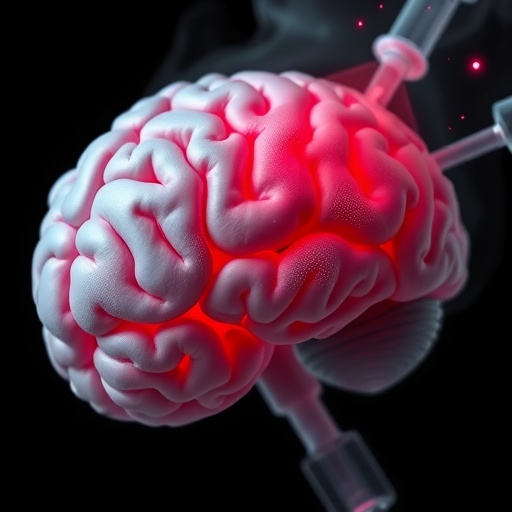In a groundbreaking study published in BMC Psychiatry in 2025, researchers have unveiled critical new insights into the neurobiological underpinnings of methamphetamine-induced psychosis (MAP). This condition, which affects nearly half of individuals with methamphetamine use disorders (MUD), manifests through transient psychotic symptoms resembling schizophrenia. Despite the clinical relevance of MAP, the precise cortical brain alterations linked to this disorder have remained elusive—until now.
The international research team employed advanced surface-based morphometry (SBM) techniques using FreeSurfer 7.1.1 software to analyze high-resolution structural MRI scans. Their study cohort included 94 male participants diagnosed with methamphetamine use disorders, subdivided into 32 with documented psychotic symptoms (MAP) and 62 without (MA), alongside 61 healthy controls (HCs). This design allowed for a nuanced comparison of cortical morphology across these distinct groups, focusing on differences in cortical thickness and volume.
Intriguingly, the MAP group displayed pronounced cortical thinning in two crucial brain regions: the left superior temporal gyrus (STG) and the right rostral anterior cingulate cortex (rACC). These areas are well-known for their involvement in auditory processing, language comprehension, and emotional regulation, all of which can be disrupted in psychotic states. The structural deficits observed in MAP patients were absent in the non-psychotic MA group and healthy controls, highlighting a potential neuroanatomical signature specific to methamphetamine-related psychosis.
Beyond the psychosis cohort, the study also revealed cortical volume reductions in the MA group compared to healthy participants. Specifically, volume decreases were found in the left caudal middle frontal gyrus (cMFG) and the superior parietal cortex (SPC). These brain regions underpin crucial executive functions, working memory, and attentional processes. Such findings suggest that even methamphetamine users without psychotic symptoms experience subtle but significant cortical impairments, possibly linked to the drug’s neurotoxic effects.
A particularly compelling aspect of the research was the positive correlation identified between cortical volume in the left cMFG and craving severity, measured via the visual analog scale (VAS). This relationship underscores the potential role of structural brain alterations in mediating addictive behaviors, offering a biological lens through which craving and relapse risk might be better understood and targeted therapeutically.
The involvement of the superior temporal gyrus and anterior cingulate cortex in psychosis adds to a growing body of evidence implicating these regions in schizophrenia-spectrum disorders. It is proposed that damage or thinning in these critical nodes disrupts neural circuits governing auditory hallucinations and emotional dysregulation, phenomena frequently observed in MAP. This connection may serve as a neuropathological bridge between substance-induced and primary psychotic disorders.
Methodologically, the use of surface-based morphometry represents a significant advancement, as it affords a sensitive and precise measurement of cortical features. Unlike volumetric methods that treat the brain as a mass, SBM analyzes the brain’s cortical sheet, yielding detailed maps of thickness and surface area changes. This granularity enhances detection of subtle region-specific alterations that conventional imaging might overlook.
The findings carry profound clinical implications. By delineating distinct cortical signatures associated with MAP, clinicians can aspire towards more accurate diagnoses and personalized intervention strategies. Such structural biomarkers may eventually guide the development of targeted therapies aimed at halting or reversing cortical atrophy, particularly in critical temporal and limbic regions implicated in psychotic symptomatology.
Moreover, the differentiation in cortical alterations between MAP and non-psychotic MUD patients emphasizes the heterogeneity within methamphetamine users. Recognizing these neurobiological subtypes might inform risk stratification approaches, enabling earlier identification of individuals prone to psychosis and more tailored monitoring routines.
This pioneering study also highlights the pressing need for integrating neuroimaging biomarkers into addiction psychiatry research. Future longitudinal investigations will be essential to discern whether cortical thinning in STG and rACC precedes or follows psychotic episodes, shedding light on causality and potential windows for intervention.
In summary, this comprehensive surface-based analysis provides the most detailed characterization to date of cortical morphology in methamphetamine-related psychosis. It establishes a compelling structural foundation for the clinical phenomena observed, bridging neuroanatomy with psychopathology and addiction neuroscience. As methamphetamine use proliferates globally, such insights are invaluable in combatting the severe psychiatric sequelae associated with this potent stimulant.
By uncovering specific region-focused cortical deficits related to psychotic symptoms and craving, this study opens new avenues for research and clinical management. Future efforts might explore restorative therapies such as neuromodulation or neuroprotective agents that could ameliorate cortical damage and improve patient outcomes. Ultimately, these advances affirm the growing power of neuroimaging to elucidate complex brain-behavior relationships in addiction and psychosis.
Subject of Research: Neurobiological mechanisms and cortical morphological alterations in methamphetamine-induced psychosis
Article Title: Cortical morphological alterations in methamphetamine-induced psychosis: a surface-based morphometry study
Article References:
Shen, D., Luo, D., Lai, M. et al. Cortical morphological alterations in methamphetamine-induced psychosis: a surface-based morphometry study. BMC Psychiatry (2025). https://doi.org/10.1186/s12888-025-07603-8
Image Credits: AI Generated




